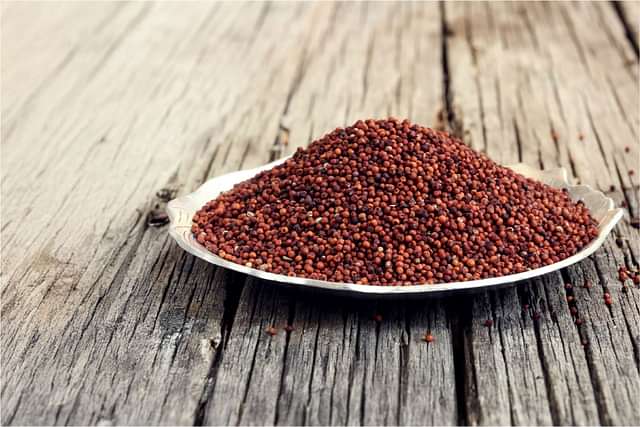Ragi
Ragi, or finger millet (Eleusine coracana), is a nutritious grain primarily cultivated in Africa and Asia's dry and semi-arid regions. Ragi, native to East Africa, has been a staple for millions because it is highly drought-resistant and thrives with minimal water requirements. It thrives best in poor soil, perfect for subsistence agriculture. Ragi is high in calcium, iron, and dietary fibre and offers several health benefits, including helping with digestion and controlling diabetes. Its use in traditional foods, such as porridge, bread, and fermented drinks, is vital to food security. The following article will explore the nutritional value, source, and ragi benefits when used regularly.
Last updated on : 18 Aug, 2025
Read time : 12 mins

What is Ragi?
Ragi, or finger millet (Eleusine coracana), is a small-seeded cereal crop that is very nutritious and adaptable to many environmental conditions. It is indigenous to the Ethiopian highlands and is extensively grown in India. However, it has only recently become more significant due to its health. Ragi, in particular, is high in calcium, iron, and certain essential amino acids like methionine, often missing in the diets of poorer populations who subsist mainly on staple cereals like rice and wheat. It is also gluten-free, making it an ideal grain for those with gluten intolerance or celiac disease.
Ragi is also low in glycemic index, which helps to keep blood sugar levels constant and is a good food for diabetic people. Furthermore, its high dietary fibre content aids digestion, promotes satiety and can assist in weight management. Ragi for weight loss has been one of the essential facets of Ragi usage. It is drought tolerant and requires minimal inputs, making it an environmentally friendly crop for farmers, particularly in rain-fed, marginal agricultural lands.
Source of Ragi
Ragi, or finger millet (Eleusine coracana), is indigenous to the Ethiopian highlands of eastern Africa, where it has been under cultivation for millennia. It then expanded into other parts of Africa and Asia, especially India, where it is a significant food crop today. Since it thrives in harsh and dry environments, it has become a favourite staple in arid and semi-arid areas. Ragi is mainly produced in India, Nepal, and some parts of Africa, such as Uganda and Kenya. Besides, it is critical to food security as it is drought-resistant and nutritious for human consumption.
Key Facts
| Feature | Details |
| What is Ragi? | Ragi, or finger millet, is a cereal grain that originated in the highlands of Ethiopia and Uganda but is grown extensively in India. It is very nutritious, with high calcium and iron content and notably rich in protein and essential amino acids, making it particularly popular among health-conscious individuals. |
| Source | Ragi is a crop indigenous to the Ethiopian Highlands and was brought to India about 4000 years ago. It is mainly cultivated in the arid and semi-arid regions of Eastern Africa and India and thrives in nutrient-poor soils with lower precipitation. |
| Alternative Names |
|
| Nutritional Value |
|
| Health Benefits |
|
| Side effects | Ragi, or finger millet, is usually healthy and harmless but sometimes can have bad reactions. But if one eats a lot of ragi, which is high in fibre, it could cause some gastrointestinal problems like gas or constipation, especially for those who aren't used to such a high-fibre diet |
| Forms Available |
|
| Precautions |
|
| Interactions | Ragi, finger millet, usually does not interact with any medicines. However, it is high in fibre, and if taken at the same time as some oral medications, it might interfere with the absorption of those medications. |
| Storage | Ragi, or finger millet as it is called, should be kept in an air-tight container in a cool, dry place; otherwise, it absorbs the moisture and becomes rancid. Store it in the refrigerator or freezer to keep it longer and fresh. |
Alternative Name of Ragi
Many names across different regions refer to Ragi. It is called finger millet in English. In India, it has several local names, such as Ragi in Kannada and Telugu; in Hindi, it is called mandua, Kezhvaragu in Tamil, Nachni in Marathi, and Mandia in Odia. It is called Dagussa in Africa (especially Ethiopia). In Nepal, it is called Kodo. These other names reflect Ragi's wide-growing popularity and cultural influence over many different places and how much of a nutritious and adaptable crop it is.
Nutritional Value of Ragi
Ragi is highly valued for its exceptional nutritional profile, making it a vital component of a healthy diet. Here is the detailed Ragi nutrition value:
- High in Calcium: Ragi contains about 344 mg of calcium per 100g, which promotes strong bones.
- Rich in Iron: Helps prevent anaemia with significant iron content (3.9 mg per 100g).
- Good Source of Dietary Fiber: Aids digestion and promotes satiety, helping manage weight.
- Gluten-Free: Ideal for those with celiac disease or gluten intolerance.
- Low-Glycemic Index: Helps manage blood sugar levels and benefits diabetics.
- Essential Amino Acids: Contains methionine and other amino acids necessary for general well-being.
Health Benefits of Ragi
Ragi or finger millet (Eleusine coracana) is a storehouse of nutrients providing several health benefits. Ragi flour benefits include strengthening bones, managing chronic conditions such as diabetes, and improving skin and hair health. Below are some key health benefits of Ragi:
1. Osteoporosis
Ragi is distinguished by its high calcium content, which is important for developing strong bones. Ragi has about 344 mg of calcium per 100 grams, making it the best plant source of calcium. This makes Ragi a nutritious food for preventing osteoporosis, where the bones become weak and brittle. Ragi roti, if taken regularly, supports bone mineral density, helps prevent fractures and maintain overall health. Post-menopausal women and the elderly are more likely to suffer from osteoporosis and can experience all the Ragi benefits.
2. Diabetes
Ragi has a low glycemic index, which gradually releases glucose into the bloodstream and does not cause sudden spikes in blood sugar levels. This makes it an excellent food choice for individuals with diabetes or those at risk of developing the condition. Ragi is high in dietary fibre and slows digestion, thereby improving blood sugar regulation. Ragi can be consumed as Ragi Mudde, proven to help control blood sugar and improve insulin sensitivity when taken regularly.
3. High Cholesterol
Ragi is high in dietary fibre and helps in controlling cholesterol levels. The soluble fibre in Ragi combines with the cholesterol in the intestines and prevents it from being absorbed into the blood. It also helps decrease the amount of LDL (bad) cholesterol and increase the amount of HDL (good) cholesterol. Ragi is also full of polyphenols and antioxidants that aid in lowering oxidative stress and inflammation, which can lead to high cholesterol and cardiovascular diseases. So, adding Ragi to the diet will help keep the heart healthy and decrease the possibility of heart disease.
4. Anti-Wrinkle
Ragi is a natural anti-ageing food. It is loaded with antioxidants, especially methionine and lysine, two essential amino acids that help tissue repair and keep the skin elastic. These antioxidants help neutralise the free radicals that cause skin ageing, thus reducing the appearance of wrinkles and fine lines. Ragi’s anti-ageing benefits are precious for maintaining healthy skin as we age, promoting a youthful complexion.
5. Anti-Dandruff
Ragi contains amino acids and antimicrobial properties that help combat dandruff. Ragi is full of essential nutrients like iron and zinc, which are very good for the scalp and prevent dryness, one of the leading causes of dandruff. If taken regularly, Ragi promotes healthier, stronger hair and can eliminate many common scalp issues, such as flakiness and dandruff. Also, ragi-based hair packs or treatments are very good for the scalp.
6. Supplies Essential Amino Acids
Ragi is high in essential amino acids, especially methionine, lysine, and threonine. These amino acids are necessary for many functions of the body, including tissue repair, the metabolism of fats, and the preservation of muscle mass. For example, methionine helps detoxify harmful substances in the liver, and lysine aids in calcium absorption and collagen formation. The body does not produce these amino acids, so eating Ragi can help meet daily dietary needs, especially for vegetarians and vegans.
7. Fortifies Bone Density
Ragi is high in calcium and phosphorus, making it an excellent food for increasing bone density. They all work in combination to help build strong bones and avoid any kind of bone disease. Children are in their developmental years, and Ragi is an excellent source of calcium needed for strong bones and teeth. Ragi is an excellent source of calcium and helps maintain bone mass in adults and the elderly, thus lowering the chance of bone degeneration and osteoporosis.
Precautions While Eating Ragi
Although ragi is very healthy and has many advantages, one must be careful when adding it to one's diet. Here are a few precautions while taking ragi:
- Its high fibre content may cause digestive discomfort, particularly in those unaccustomed to a fibre-rich diet.
- Ragi should be gradually incorporated into the diet, and plenty of water should be consumed to facilitate digestion.
- Ragi should also be eaten in moderation by people with kidney problems because it contains oxalates that can lead to the formation of kidney stones in predisposed people. Those with a history of kidney stones should check with a doctor before they start chowing down on massive amounts of Ragi. Besides, ragi should be kept in a cool, dry place, or else it will get infested with insects or fungus. If purchasing pre-ground Ragi flour, check for freshness and ensure it is free from contamination.
- Finally, although Ragi itself is gluten-free, it would be essential to check that it hasn't been contaminated with gluten through contact with other gluten-containing grains at some point during the processing or packaging. However, with these precautions, Ragi can be eaten without any danger as a part of a balanced diet. Individuals with gluten intolerance should ensure Ragi is processed in a gluten-free facility to avoid cross-contamination.
How to Use Ragi
Ragi is a very healthy grain which can be used in many forms to make many delicious recipes. Well here's how to use ragi:.
1. Ragi Flour Preparation:
Steps to use:
- Buy pre-ground Ragi flour or grind whole Ragi grains into flour in a blender or grain mill.
- Sieve the flour to remove any coarse particles.
2. Ragi Porridge (For Breakfast):
Steps to use:
- Add 2-3 tbsp of Ragi flour in cold water and paste.
- In a pan, heat up a cup of water, and slowly stir in the Ragi paste.
- Cook on low heat until the mixture thickens. Add milk or sweeteners like jaggery or honey as desired.
3. Ragi Roti (Flatbread):
Steps to use:
- Mix Ragi flour with hot water and a little salt and oil, and make it into a soft dough.
- Roll the dough into small balls and flatten them into thin circles.
- Cook the flatten dough in a preheated pan until golden brown on both sides.
4. Ragi Malt Drink:
Steps to use:
- 2 tbsp ragi flour with cold milk or water.
- Boil the mixture while stirring. Add a pinch of cardamom and sweetener to taste.
5. Ragi Dosa or Pancakes:
Steps to use:
- Soak Ragi flour in water with some rice flour overnight to ferment.
- Pour the fermented mixture into a hot skillet and fry up like pancakes or dosas.
This makes it easy to add Ragi to various meals, a healthy, nutrient-packed food to eat daily.
Key Takeaways
- Ragi is rich in calcium, iron, dietary fibre, and essential amino acids, making it highly beneficial for bone health, diabetes management, and cholesterol control.
- Ragi can be used in various forms, including porridge, roti, malt drinks, and dosas, offering multiple ways to incorporate it into daily meals.
- Ragi has a low glycemic index, so it stabilises blood sugar levels, making it a suitable dietary choice for individuals managing diabetes.
- Although Ragi is perfectly healthy, it should not be eaten in extreme amounts because it may cause some digestive problems. Those who have kidney problems or a history of kidney stones should talk to their doctors before they start consuming large amounts of Ragi.
Conclusion
Ragi offers a wide array of health benefits, ranging from improved bone density and diabetes management to enhanced skin and hair health. Rich in calcium, fibre, antioxidants, and essential amino acids, it is particularly beneficial for children, the elderly, and those seeking natural remedies for chronic conditions. With its versatility in cooking and ease of incorporation into daily meals, it is a wholesome grain that supports health. When consumed mindfully and in moderation, it can be a valuable addition to a balanced, health-conscious diet for all age groups.
FAQs
Can Ragi be eaten daily?
Does Ragi have side effects?
Does Ragi cause gas?
When should we avoid Ragi?
Is Ragi heavy to digest?
Is Ragi better than rice?
Can we mix Ragi with milk?
Is Ragi better than Atta?
Can we eat Ragi at night?
Do we need to soak Ragi overnight?
References
- Devisetty Bilvani, & Malathy .S. (2023). FORMULATING AND FORTIFYING THE RAGI PORRIDGE MIX WITH WALNUT AND LEMON SEED POWDER AND EVALUATING ITS NUTRITIONAL, SENSORY, AND SHELF-LIFE CHARACTERISTICS. 10(6), 819. https://www.researchgate.net/publication/372412088_formulating_and_fortifying_the_ragi_porridge_mix_with_walnut_and_lemon_seed_powder_and_evaluating_its_nutritional_sensory_and_shelf-life_characteristics
- Jagati, P., Mahapatra, I., & Dash, D. (2021). Finger millet (Ragi) as an essential dietary supplement with key health benefits: A review. International Journal of Home Science, 7(2), 94–100. https://doi.org/10.22271/23957476.2021.v7.i2b.1152
- Swamy. (n.d.). REVIEW ARTICLE ORIGIN, DISTRIBUTION, TAXONOMY, BOTANICAL DESCRIPTION, GENETIC DIVERSITY AND BREEDING OF Luffa spp. https://doi.org/10.24941/ij
Explore other categories
Disclaimer
Top-Selling Medicines:
...View more
Top-OTC medicines:
...View more
Company
About UsHealth ArticleHealth StoriesDiseases & Health ConditionsAyurvedaAll MedicinesAll BrandsNeed HelpFAQSubscribe
Registered Office Address
Grievance Officer
Download Truemeds
Contact Us
Our customer representative team is available 7 days a week from 9 am - 9 pm.
v4.3.9
2025 - Truemeds | All rights reserved. Our content is for informational purposes only. See additional information.
Our Payment Partners






















